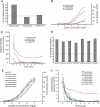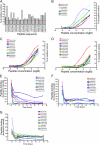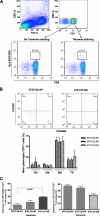For protection from HIV-1 infection, more might not be better: a systematic analysis of HIV Gag epitopes of two alleles associated with different outcomes of HIV-1 infection
- PMID: 22072744
- PMCID: PMC3255815
- DOI: 10.1128/JVI.05721-11
For protection from HIV-1 infection, more might not be better: a systematic analysis of HIV Gag epitopes of two alleles associated with different outcomes of HIV-1 infection
Abstract
A subset of women in the Pumwani Sex Worker Cohort, established in 1985 in Nairobi, Kenya, remains uninfected despite repeated high-risk exposure (HIV-exposed, seronegative [HESN]) through active sex work. This HESN phenotype is associated with several alleles of human leukocyte antigens (HLAs) and specific CD8(+) and CD4(+) T cell responses to HIV-1. The associations of HLA alleles with differential HIV-1 infection are most likely due to their different abilities to present antigen and the different immune responses they induce. The characteristics of epitopes of HLA alleles associated with different outcomes of HIV-1 infection might therefore point to a vital clue for developing an effective vaccine. In this study, we systematically analyzed HIV-1 clade A and D Gag CD8(+) T cell epitopes of two HLA class I alleles associated with different outcomes of HIV-1 infection. Binding affinity and off-rates of the identified epitopes were determined. Gamma interferon (IFN-γ) enzyme-linked immunospot (ELISpot) assays with patient peripheral blood mononuclear cells (PBMCs) validated the epitopes. Epitope-specific CD8(+) T cells were further phenotyped for memory markers with tetramer staining. Our study showed that the protective allele A*01:01 recognizes only three Gag epitopes. By contrast, B*07:02, the allele associated with susceptibility, binds 30 epitope variants. These two alleles differ most importantly in the spectrum of Gag epitopes they can present and not in affinity, off-rates, the location of the epitopes, or epitope-specific Tem/Tcm frequencies. The binding of more epitopes and strong IFN-gamma ELISpot responses are associated with susceptibility to HIV-1 infection, while more focused antigen recognition of multiple subtypes is protective. Rational vaccine design should take these observations into account.
Figures







Similar articles
-
The effect of HLA polymorphisms on the recognition of Gag epitopes in HIV-1 CRF01_AE infection.PLoS One. 2012;7(7):e41696. doi: 10.1371/journal.pone.0041696. Epub 2012 Jul 27. PLoS One. 2012. PMID: 22848569 Free PMC article.
-
CD8+ T cells specific for conserved, cross-reactive Gag epitopes with strong ability to suppress HIV-1 replication.Retrovirology. 2018 Jul 3;15(1):46. doi: 10.1186/s12977-018-0429-y. Retrovirology. 2018. PMID: 29970102 Free PMC article.
-
Frequencies of Gag-restricted T-cell escape "footprints" differ across HIV-1 clades A1 and D chronically infected Ugandans irrespective of host HLA B alleles.Vaccine. 2015 Mar 30;33(14):1664-72. doi: 10.1016/j.vaccine.2015.02.037. Epub 2015 Feb 26. Vaccine. 2015. PMID: 25728323 Free PMC article.
-
Identification of highly conserved and broadly cross-reactive HIV type 1 cytotoxic T lymphocyte epitopes as candidate immunogens for inclusion in Mycobacterium bovis BCG-vectored HIV vaccines.AIDS Res Hum Retroviruses. 2000 Sep 20;16(14):1433-43. doi: 10.1089/08892220050140982. AIDS Res Hum Retroviruses. 2000. PMID: 11018863 Review.
-
The influence of HLA/HIV genetics on the occurrence of elite controllers and a need for therapeutics geotargeting view.Braz J Infect Dis. 2021 Sep-Oct;25(5):101619. doi: 10.1016/j.bjid.2021.101619. Epub 2021 Sep 22. Braz J Infect Dis. 2021. PMID: 34562387 Free PMC article. Review.
Cited by
-
Natural and cross-inducible anti-SIV antibodies in Mauritian cynomolgus macaques.PLoS One. 2017 Oct 5;12(10):e0186079. doi: 10.1371/journal.pone.0186079. eCollection 2017. PLoS One. 2017. PMID: 28982126 Free PMC article.
-
HIV-1 Subtypes and 5'LTR-Leader Sequence Variants Correlate with Seroconversion Status in Pumwani Sex Worker Cohort.Viruses. 2017 Dec 23;10(1):4. doi: 10.3390/v10010004. Viruses. 2017. PMID: 29295533 Free PMC article.
-
Specific CD8+ T cell responses correlate with control of simian immunodeficiency virus replication in Mauritian cynomolgus macaques.J Virol. 2012 Jul;86(14):7596-604. doi: 10.1128/JVI.00716-12. Epub 2012 May 9. J Virol. 2012. PMID: 22573864 Free PMC article.
-
Influence of HLA class I haplotypes on HIV-1 seroconversion and disease progression in Pumwani sex worker cohort.PLoS One. 2014 Jul 3;9(7):e101475. doi: 10.1371/journal.pone.0101475. eCollection 2014. PLoS One. 2014. PMID: 24992306 Free PMC article.
-
Natural Immunity against HIV-1: Progression of Understanding after Association Studies.Viruses. 2022 Jun 8;14(6):1243. doi: 10.3390/v14061243. Viruses. 2022. PMID: 35746714 Free PMC article. Review.
References
-
- Ahlers JD, Belyakov IM. Lessons learned from natural infection: focusing on the design of protective T cell vaccines for HIV/AIDS. Trends Immunol. 31:120–130 - PubMed
-
- AIDS Vaccine Advocacy Coalition 2004. Support for the RV144 HIV vaccine trial. Science 305:177–180; author reply 177–180 - PubMed
-
- Alimonti JB, et al. 2006. Characterization of CD8 T-cell responses in HIV-1-exposed seronegative commercial sex workers from Nairobi, Kenya. Immunol. Cell Biol. 84:482–485 - PubMed
-
- Alimonti JB, et al. 2005. CD4+ T cell responses in HIV-exposed seronegative women are qualitatively distinct from those in HIV-infected women. J. Infect. Dis. 191:20–24 - PubMed
Publication types
MeSH terms
Substances
Grants and funding
LinkOut - more resources
Full Text Sources
Other Literature Sources
Medical
Research Materials

